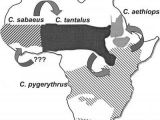It is known that monkeys infected us with HIV. But a new research at the University of Arizona in Tucson revealed that they did this much more recently than previously believed.
The monkey HIV strain, called simian immunodeficiency virus (SIV), was found by a new genetic analysis on African green monkeys, to have first emerged in those monkeys after they split into four species, about 3 million years ago. Previously, it was believed SIV infected the common ancestor of green monkeys before the split, much earlier.
"Studying SIV helps us learn more about HIV. This finding sheds light on the future direction of HIV evolution," said first author Joel Wertheim, a doctoral candidate in the UA department of ecology and evolutionary biology.
"All SIVs and HIVs have a common ancestor", added senior author Michael Worobey, a UA assistant professor of ecology and evolutionary biology.
The new research points that African green monkeys' SIVs may have missed their virulence later than believed and today green monkeys almost never experience simian AIDS. How SIV lost its virulence could explain the future evolution of HIV. The new research points that various SIVs arose because SIVs were transmitted horizontally, between primate species and generated novel host-specific strains only after inter-species transmission.
"HIV arose from chimpanzee SIV that was transmitted to humans, probably when people had contact with chimpanzee blood from hunting and butchering the animals," said Worobey.
The new research was made as UA researchers were not convinced by the theory that SIV appeared before the split of the green monkey species. They sequenced the mitochondrial DNA genes of the four modern species of African green monkeys: sabaeus monkey (Chlorocebus sabaeus), from western Africa; the tantalus monkey (Chlorocebus tantalus) from central Africa; the vervet monkey (Chlorocebus pygerythrus) from eastern/southern Africa; and the grivet monkey (Chlorocebus aethiops) from northeast Africa.
"We put together, for the first time, a really solid phylogeny for African green monkeys, which we didn't have before," said Worobey.
In case of an infection in the common ancestor of the four green monkeys, the SIV family tree should fit that of the green monkeys; the DNA analysis did not find this.
"The monkey tree was significantly different from the virus tree," Wertheim said. The relative ages and closeness of the green monkey SIVs, correlated with the geographic distribution of the monkeys, revealed the probable transmission pathway of SIV.
The infection could have emerged in the westernmost species, sabaeus, moved east into neighboring tantalus and either moved southeast into vervets and then north into grivets or northeast into grivets and then south into vervets.
"I was surprised that the geography could explain the virus phylogenetic tree, how well it fit. You just look and -- there it is!" said Wertheim.
In the border zones where two African green monkey species' ranges overlap, transmission could have taken place during interspecies mating or fights and hybrid monkeys in these areas are known.
"Some of the trends we see give new evidence on how quickly or slowly these changes take place." said Worobey.
The UA team pointed that lab tests suggests HIVs from the late 1980s are more virulent than HIVs from the 2000s. "For HIV, the really cool thing is that these changes can take place on a more rapid timeline that previously thought." said Worobey.
"Understanding how emerging infectious diseases evolve in their natural host organism helps us understand the disease's possible trajectory." said Wertheim.
The team's next projects are to detect precisely when SIV infected African green monkeys and SIV's evolution in other species of monkeys, too.

 14 DAY TRIAL //
14 DAY TRIAL // 
